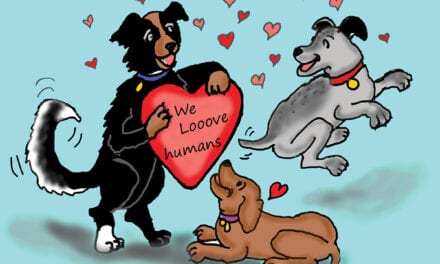
We all know that dogs have a sense of smell far superior to that of humans, but you might be astounded to learn just how keen is their olfactory system. I looked it up to find that, as humans, we have around 5 million olfactory receptors to employ in identifying scents, whereas dogs have between 225-300 million. Let that sink in for a minute. That’s 220-295 million more opportunities to view the world through scent.
We, as mere humans, take scent very seriously. As inferior as our sense of smell is, we use scent to help us navigate our existence. We’ve all given a carton of milk a little sniff before pouring a glass—just in case that sour smell comes through, warning us not to drink it. Good smells from the kitchen can make our stomachs growl and our mouths water. And the whiff of a familiar perfume can remind us of someone, ushering in a flood of memories. If you get away from it, you can smell the ocean in the air or breathe in the smell of pine trees. We mountain dwellers have gotten used to the smell of pine so that it becomes undetectable unless it’s closely handled, releasing the scent anew. The mere mention of burnt toast, baby powder, grilled meat, and chlorine rockets our brains to those familiar scents. Now try to bend your mind around the olfactory experience of a dog.
The other day, my 5-year-old grandson wanted to know why our dog Daisy kept sniffing his Spiderman sweatshirt. I said that she can smell that he went to school, to the library, and to two different playgrounds. I told him that by sniffing him, she could detect that he played with two boys and three girls at recess; that his Taekwondo teacher is a woman; that he ate tacos for dinner yesterday and that he put a crayon in his pocket. Just by sniffing him, she knew all the people in his life she’d sniffed before—his mom, his sister, and me because I hugged him. He giggled at that and wanted to know more. It became a little game listing all the things Daisy learned just by sniffing his sweatshirt, but I’m sure that not only is it the truth, it’s just a tiny bit of the things she actually detected.
“It became a little game listing all the things Daisy learned just by sniffing his sweatshirt… ”
We humans often talk about information overload. So intolerable, it drives us to drop social media and turn off the news and silence our phones. Imagine if we had to sort out all the information a dog gathers in one car ride—with the scents speeding by at 50 miles per hour. And the information gathering isn’t the only superior factor. A dog’s system includes two separate chambers—one for smelling and one for breathing, so that exhaling doesn’t dilute the value of scents. The wetness of their nose belies the moisture in their olfactory canal that is also helpful in trapping scents, and they have a special chamber above the roof of their mouth to process every scent gathered. Each nostril collects its own scents to better navigate its origin. You can see in a dog’s behavior how much scent plays into their life. If someone smells ‘off’ they won’t want to come near. They stand back and bow their head, shifting. If they smell decay—that telltale sign death is in the air—they do the same thing. But not always. We’ve had numerous dogs that sought out dead things to roll in and they came home in a desperate state of needing a bath.
If you’ve ever been to the mall at Christmas time, you might feel overwhelmed by sensory overload. At least that’s been my experience. Imagine that same mall but with every person you pass, you get a whiff and a whole list of everything about them—what they ate recently, if they are male or female, full or empty, dehydrated or diabetic, and a whole lot more. That level of sensory overload would put most of us in a straight jacket. Yet, dogs take all that information and use it to navigate their world. They don’t beg off their responsibilities to declare a ‘me day.’
Of course, we humans benefit from dogs’ ability to use their noses to better our world. If a person smells ‘off,’ they will warn us. If there is smoke in the air, they know before we do. Dogs have been known to detect seizures before they happen, sniff out cancerous areas of the body, become protective when a woman is expecting. Dogs can be trained to be the eyes of a blind person and a support animal for people with anxiety, not to mention cheering people up who are in the hospital, simply by showing up. They know when wildlife is near, which can be exceptionally helpful if you live in the forest. And many dogs will demonstrate their loyalty by coming between an animal on the attack and their human. Whenever a member of our family took a walk in the forest, we brought at least one of the dogs with us, knowing their protectiveness could possibly save our lives.
As to our sensitivity to dogs, we pick up on the scents of our dogs—good or bad. We can smell the snow on their fur when they come in from being outside in the winter—I call it smelling the cold. And we’ve all heard the expression, ‘smells like wet dog’ about water-soaked fur. Most of us could probably recognize our puppy’s breath, especially if they, like our Daisy, like to touch noses. And we smell the heat on their fur when they’ve napped in a warm patch of sun. For all our inferior sniffing skills, our noses can be attuned to the scents that are uniquely our dog. Never to the level that our dogs are attuned to our scent, but still—the nose knows.



